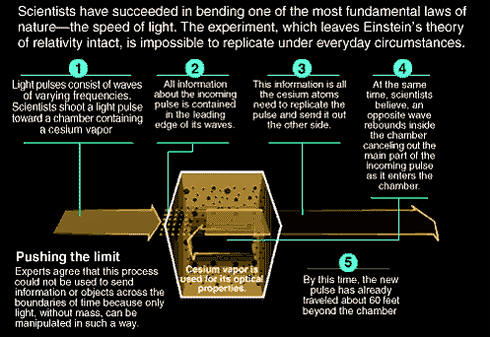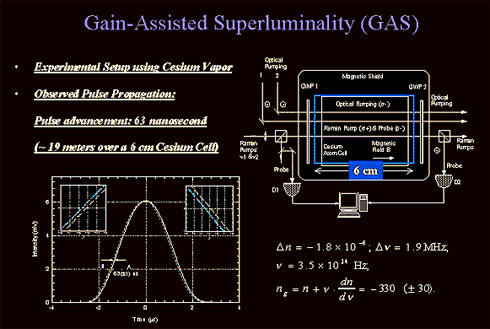Speed of Light Exceeded in Labs
Gain Assisted Superluminal Light Propagation
by Dr. Lijun Wang
Scientists have apparently broken the universe’s speed limit. For generations, physicists believed there is nothing faster than light moving through a vacuum - a speed of 186,000 miles per second. But in an experiment in Princeton, N.J., physicists sent a pulse of laser light through cesium vapor so quickly that it left the chamber before it had even finished entering. The pulse traveled 310 times the distance it would have covered if the chamber had contained a vacuum. This seems to contradict not only common sense, but also a bedrock principle of Albert Einstein’s theory of relativity, which sets the speed of light in a vacuum, about 186,000 miles per second, as the fastest that anything can go. But the findings--the long-awaited first clear evidence of faster-than-light motion--are "not at odds with Einstein," said Lijun Wang, who with colleagues at the NEC Research Institute in Princeton, N.J., report their results in today’s issue of the journal Nature. "However," Wang said, "our experiment does show that the generally held misconception that ’nothing can move faster than the speed of light’ is wrong." Nothing with mass can exceed the light-speed limit. But physicists now believe that a pulse of light--which is a group of massless individual waves--can. To demonstrate that, the researchers created a carefully doctored vapor of laser-irradiated atoms that twist, squeeze and ultimately boost the speed of light waves in such abnormal ways that a pulse shoots through the vapor in about 1/300th the time it would take the pulse to go the same distance in a vacuum. As a general rule, light travels more slowly in any medium more dense than a vacuum (which, by definition, has no density at all). For example, in water, light travels at about three-fourths its vacuum speed; in glass, it’s around two-thirds. The ratio between the speed of light in a vacuum and its speed in a material is called the refractive index. The index can be changed slightly by altering the chemical or physical structure of the medium. Ordinary glass has a refractive index around 1.5. But by adding a bit of lead, it rises to 1.6. The slower speed, and greater bending, of light waves accounts for the more sprightly sparkle of lead crystal glass.
The NEC researchers achieved the opposite effect, creating a gaseous medium that, when manipulated with lasers, exhibits a sudden and precipitous drop in refractive index, Wang said, speeding up the passage of a pulse of light. The team used a 2.5-inch-long chamber filled with a vapor of cesium, a metallic element with a goldish color. They then trained several laser beams on the atoms, putting them in a stable but highly unnatural state. In that condition, a pulse of light or "wave packet" (a cluster made up of many separate interconnected waves of different frequencies) is drastically reconfigured as it passes through the vapor. Some of the component waves are stretched out, others compressed. Yet at the end of the chamber, they recombine and reinforce one another to form exactly the same shape as the original pulse, Wang said. "It’s called re-phasing." The key finding is that the reconstituted pulse re-forms before the original intact pulse could have gotten there by simply traveling though empty space. That is, the peak of the pulse is, in effect, extended forward in time. As a result, detectors attached to the beginning and end of the vapor chamber show that the peak of the exiting pulse leaves the chamber about 62 billionths of a second before the peak of the initial pulse finishes going in. That is not the way things usually work. Ordinarily, when sunlight -- which, like the pulse in the experiment, is a combination of many different frequencies -- passes through a glass prism, the prism disperses the white light’s components. This happens because each frequency moves at a different speed in glass, smearing out the original light beam. Blue is slowed the most, and thus deflected the farthest; red travels fastest and is bent the least. That phenomenon produces the familiar rainbow spectrum. But the NEC team’s laser-zapped cesium vapor produces the opposite outcome. It bends red more than blue in a process called "anomalous dispersion," causing an unusual reshuffling of the relationships among the various component light waves. That’s what causes the accelerated re-formation of the pulse, and hence the speed-up In theory, the work might eventually lead to dramatic improvements in optical transmission rates. "There’s a lot of excitement in the field now," said Steinberg. "People didn’t get into this area for the applications, but we all certainly hope that some applications can come out of it. It’s a gamble, and we just wait and see." From The Anderson Institute @ http://www.andersoninstitute.com/gain-assisted-superluminal-light-propogation.html |
LANL scientist makes radio waves
travel faster than light

Scientist John Singleton insists that Albert Einstein wouldn't be mad at him, even though at first blush Singleton appears to have twisted the famous physicist's theories about light into a pretzel.
by Sue Vorenberg
Most people think Einstein said that nothing can travel faster than the speed of light, but that's not really the case, Singleton said.
Einstein predicted that particles and information can't travel faster than the speed of light — but phenomenon like radio waves? That's a different story, said Singleton, a Los Alamos National Laboratory Fellow.
Singleton has created a gadget that abuses radio waves so severely that they finally give in and travel faster than light.
The polarization synchrotron combines the waves with a rapidly spinning magnetic field, and the result could explain why pulsars — which are super-dense spinning stars that are a subclass of neutron stars — emit such powerful signals, a phenomenon that has baffled many scientists, Singleton said.
"Pulsars are rapidly rotating neutron stars that emit radio waves in pulses, but what we don't know is why these pulses are so bright or why they travel such long distances," Singleton said. "What we think is these are transmitting the same way our machine does."
And beyond explaining what has been a bit of a mystery to the astronomical community, Singleton's discovery could have wide-ranging technological impacts in areas such as medicine and communications, he said.
"Because nobody's really thought about things that travel faster than light before, this is a wide-open technological field," Singleton said.
One possible use for the resulting speedy radio waves — which are packed into a very powerful wave the size of a pencil point — could be the creation of a new generation of cell phones that communicate directly to satellites, rather than transmitting through relay towers as they now do.
Those phones would have more reliable service and would also be more difficult for hackers to intercept, Singleton said.
Another application could be in very targeted chemotherapy, where a patient takes the drugs, and the radio waves are used to activate them very specifically in the area around a tumor, he said.
The concept of phenomenon traveling faster than light has been discussed in the back alleys of the scientific community since the 1970s, but observations were based on strange aberrations, like the distorted images of stars as they traveled near the speed of light, said Mario Perez, a Los Alamos scientist who worked with Singleton on the project.
"Radio astronomers found sources that looked like things were traveling faster than light, but they were not truly superluminal, like this is," Perez said.
And other effects have also shown the possibility of phenomenon traveling faster than light, but Singleton's experiment has taken that to a new level, Singleton said.

"If you take a laser and shine it on the moon and swing it rather gently, for example, the spot on the moon travels faster than the speed of light," Singleton said. "If an effect can do that, it makes you wonder if you can do things with light to get the equivalent of a sonic boom."
That's what the faster-than-light radio waves — more scientifically known as superluminal transmissions — do. They're the light version of a sonic boom, he said.
"When something travels faster than its own wave speed you get a very large disturbance," Singleton said. "And these powerful signals that result, well, this would be how E.T., if he were out there, would likely try to communicate with us."
If Einstein were still alive, he probably wouldn't be all that surprised by the discovery, Perez said, even if it does seem on the surface to conflict with some of his theories.
"He might have thought, 'why did this take so long,' " Perez said.
Last week, the two scientists presented the work to the American Astronomical Society at its conference in Austin, Texas.
Singleton wasn't sure how it would be received by the astronomical community, but so far, other scientists seem very interested in his work, he said.
"I thought there would be more resistance to it, because traditional astronomers are very resistant to things traveling faster than the speed of light," Singleton said.
In the next few years, the scientists plan to build a series of newer, more powerful machines to further demonstrate the technology, Perez added.
The Department of Energy has given them a three-year,
$3 million grant to work on the project.
And Einstein — he wouldn't be mad about that at all, Singleton said.
Contact Sue Vorenberg
at 986-3072 or svorenberg@sfnewmexican.com
at 986-3072 or svorenberg@sfnewmexican.com
Xtra Images - http://www.zamandayolculuk.com/cetinbal/AE/Arelativistic.jpg
http://www.navigadget.com/wp-content/postimages/2009/05/pulsar.jpg
For further enlightenment see –
The Her(m)etic Hermit - http://hermetic.blog.com
New Illuminati – http://nexusilluminati.blogspot.com
New Illuminati on Facebook - http://www.facebook.com/pages/New-Illuminati/320674219559
This material is published under Creative Commons Copyright (unless an individual item is declared otherwise by copyright holder) – reproduction for non-profit use is permitted & encouraged, if you give attribution to the work & author - and please include a (preferably active) link to the original along with this notice. Feel free to make non-commercial hard (printed) or software copies or mirror sites - you never know how long something will stay glued to the web – but remember attribution! If you like what you see, please send a tiny donation or leave a comment – and thanks for reading this far…
From the New Illuminati – http://nexusilluminati.blogspot.com


Please can you analysis in my web site www.timeflow.org ? Thanks.
ReplyDeleteBest Regards
Salih Kırcalar